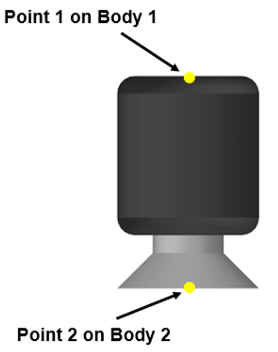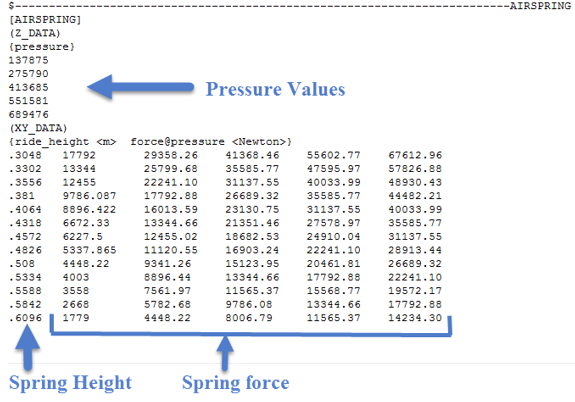AirSpring
Air springs are commonly used in trucks, buses, and rail vehicles because their internal air pressure can be increased or decreased to adjust for the load carried while maintaining ride height.
Typically a valve on the chassis is mechanically linked to an axle and if the ride height is too low the value opens to admit high pressure air to the spring from a compressor, until the ride height increases enough to close the value. Conversely if the ride height is too high the value vents air from the spring to atmosphere until the ride height decreases enough to close the value. The value has a dead band so that typical suspension ride and roll motions do not open the valve.
In some cases, air springs are used as actuators to lower and raise an axle and tires. When a truck is heavily loaded, the air spring is inflated to push the axle's tires into the road and spread the load over a greater area of road.
In other cases, air springs may connect with each other or to a reservoir. The additional volume of a reservoir, for example, decreases the spring rate since for a change in ride height the incremental change in volume as fraction of the total volume is smaller. When springs connect to one another or to a reservoir, then the resistance to flow between the springs or the spring and reservoir may be tuned to give a frequency dependent response.
Parameters
- Property File
- The AirSpring properties are stored in a TeimOrbit format property file containing a table of the spring force versus spring height for different static pressures.
- Trim Height
- Determines the initial trim height value of the AirSpring. With the given trim load and trim height, MotionSolve determines the static internal spring pressure from the data in the air spring property file.
- Trim Load
- Force applied by air spring when the spring height is the trim height. MotionSolve determines the static internal air spring pressure that yields the trim load at the trim height according to the data in the air spring property file.
- Use Bump Stop
- It is possible to include an internal bump stop to limit the AirSpring ride height. For more information, see the Bump Stop documentation.
- Scale
- The scale options enable the scaling of the force and spring height without the need to directly modify the property file.
Connecting an AirSpring
-
1. From the guidebar, select the first body to connect.
- Click Body 1 and select a
body from the modeling window.
OR
- Click the Body 1 Advanced Selector and select the required body from the dialog.
- Click Body 1 and select a
body from the modeling window.
- Similarly, select the second body to connect by clicking the Body 2 input collector.
-
Select a point and enter the location where the spring connects to Body
1.
- Click Point on Body 1 and select a point from the
modeling window.
OR
- Click the Point on Body 1 Advanced Selector and select the required point from the dialog.
- Click Point on Body 1 and select a point from the
modeling window.
-
Similarly, select the second point.
Typically, air springs act between the chassis and an axle. Point 1 on Body 1 defines the top of the air spring, while Point 2 on Body 2 defines the bottom of the air spring.
Figure 1. AirSpring connection points 
- Open the AirSpring Entity Editor to edit the parameters.
Property File for AirSpring
The AirSpring properties are stored in a TeimOrbit format property file containing a table of the spring force vs spring height for different static pressures. When the model is submitted to the solver, MotionSolve reads the air spring properties from the TeimOrbit file for use during the simulation. If the units specified in air spring property file differ from the model, MotionSolve converts the air spring properties to model units, however it leaves the property file unchanged.
$---------------------------------------------------------------------ALTAIR_HEADER
[ALTAIR_HEADER]
FILE_TYPE = 'asg'
FILE_VERSION = 1.0
FILE_FORMAT = 'ASCII'
$--------------------------------------------------------------------------UNITS
[UNITS]
(BASE)
{length force angle mass time}
'm' 'newton' 'radians' 'kg' 'sec'
$--------------------------------------------------------------Airspring Properties
[PARAMETERS]
inner_diameter = .100
bag_diameter = .200
spring_height = .460
cylinder_height = .250
outer_diameter = .200
meniscus_height = .153
$-------------------------------------------------------------------------AIRSPRING
[AIRSPRING]
(Z_DATA)
{pressure}
137875 $ p0
275790 $ p1
413685 $ p2
551581 $ p3
689476 $ p4
(XY_DATA)
{spring_height <m> force@pressure <Newton>}
.3048 17792 29358.26 41368.46 55602.77 67612.96
.3302 13344 25799.68 35585.77 47595.97 57826.88
.3556 12455 22241.10 31137.55 40033.99 48930.43
.381 9786.087 17792.88 26689.32 35585.77 44482.21
.4064 8896.422 16013.59 23130.75 31137.55 40033.99
.4318 6672.33 13344.66 21351.46 27578.97 35585.77
.4572 6227.5 12455.02 18682.53 24910.04 31137.55
.4826 5337.865 11120.55 16903.24 22241.10 28913.44
.508 4448.22 9341.26 15123.95 20461.81 26689.32
.5334 4003 8896.44 13344.66 17792.88 22241.10
.5588 3558 7561.97 11565.37 15568.77 19572.17
.5842 2668 5782.68 9786.08 13344.66 17792.88
.6096 1779 4448.22 8006.79 11565.37 14234.30
Header Block
$---------------------------------------------------------------------ALTAIR_HEADER
[ALTAIR_HEADER]
FILE_TYPE = 'asg'
FILE_VERSION = 1.0
FILE_FORMAT = 'ASCII'Units Block
$--------------------------------------------------------------------------UNITS
[UNITS]
(BASE)
{length force angle mass time}
'm' 'newton' 'radians' 'kg' 'sec'Parameters Block
- Torus Major Radius = Inner Diameter/2+(Bag Diameter-Inner Diameter)/4
- Torus Minor Radius = (Bag Diameter-Inner Diameter)/4

$--------------------------------------------------------------Airspring Properties
[PARAMETERS]
inner_diameter = .100
bag_diameter = .200
spring_height = .460
cylinder_height = .250
outer_diameter = .200
meniscus_height = .153AirSpring Block
- Z_DATA
- XY_DATA
The Z_DATA sub-block gives the nominal internal spring pressure for each force versus deflection curve. The XY_DATA sub-block contains multiple force versus deflection curves.
The first column of the XY_DATA sub-block is spring height and each subsequent column is the spring force for one pressure defined in the Z_DATA sub-block. Therefore the forces in the second column correspond to the first internal pressure (137875 Newton/Meter2), and the forces in the third column correspond to the second internal pressure (275790 Newton/Meter2), and so on.

The spring height provided in the first column should cover the full range of the air spring heights. During a simulation if the spring height outside the range of height provided, MotionSolve linearly extrapolates the spring force with spring height.
Based on the trim load and trim height provided in the user interface, the Newton Raphson method is used to evaluate the equilibrium pressure from the spline data and subsequently, the force-displacement curve corresponding to the equilibrium pressure calculated is used for the simulation.
Outputs
| Type | Component |
|---|---|
| Displacement | Spring Trim Height |
| Velocity | Spring Velocity |
| Force | Spring Force |